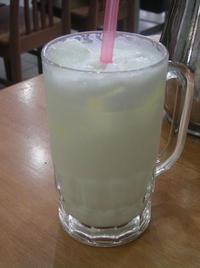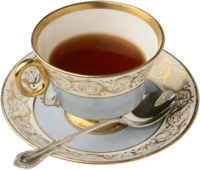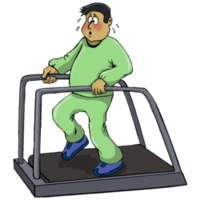Do Healthy Foods Taste Bad?

There is a valuable study in the Journal of Marketing, which I must confess is not normally on my overloaded reading list. At least it wasn’t until I discovered an astonishing number of articles that are highly relevant to our basic themes of Health, Integrated Medicine, Meaning and Purpose.
We are all constantly puzzled by the way in which so many people seem to enjoy unhealthy foods. This is a matter of enormous importance: countries like China and India are now getting fattest the fastest, partly because of their peoples’ craving for Western junk food, coupled, in many cases, with a metabolic inability to process the food in the same way that most Europeans do.
Well, according to this study, foods that we think are healthy taste worse. This is the “unhealthy = tasty intuition.” In one of the experiments, test subjects were offered a mango lassi, an Indian yogurt drink that has the consistency of a thick milkshake. Those who were told that the lassi was “unhealthy” liked the drink significantly more than those who were told the drink was “healthy.”

When I was a young student one of my teachers told me that patients always believe that if something tastes foul then it must be doing them some good. A lesson that I had learned from my grandmother when still a small child. By the age of five I already knew that any rash or snivel would mean having to take some pungent and disgusting potion: some secret recipe that had been in the family for generations. Even then I wondered how it was that so many family members had lived to great ages. It didn’t seem possible.
This research fits in with the teachings of my grandmother and my professor. People assume an inverse relationship between tastiness and healthiness. In the study people believed that what they were consuming was unhealthy, they guessed that it would taste better, be more enjoyable to eat and that they would be more likely to choose it in a test.
This is important research and has a number of practical implications for helping people to adopt more healthy eating patterns.
This reminded me of a salutary lesson. Some years ago I spent a very happy year doing a part time course in wine tasting. Fascinating topic taught by Masters of Wine who said that they could tell incredible things about a wine after the smallest taste. A couple of years ago such claims were put to the test in Bordeaux in France, which is, of course, famous for its wines. In the first experiment 54 acknowledged wine experts were asked to give their impressions of two glasses of wine: one white and one red. The wines were actually the same white wine, one of which had been tinted red with an odorless food coloring. But here it gets interesting: the experts described the “red” wine in language typically used to describe red wines. For instance one said tat the colored wine had a “flavor of crushed red fruit.” Not a single one noticed it was actually a white wine.
In a second experiment an inexpensive wine was presented to the experts in two different bottles, one fancy and one plain. The experts gave the two bottles completely different evaluations. The experimenters described their results in terms of the interaction between vision of colors and odor determination. But we can also interpret the data in terms of expectation and perspective. If we expect something to taste good it tends to do so. Yes of course you can get a nasty surprise, but there is a powerful subjective component in how we interpret sensations.
I strongly suggest that you analyze your own reactions to food. Do you believe that healthy foods have to taste awful?
This may be an important key to changing your own eating patterns.
“Life expectancy would grow by leaps and bounds if green vegetables smelled as good as bacon.”
–“Doug Larson”
“As for food, half of my friends have dug their graves with their teeth.”
–Chauncey M. Depew (American Politician and, from 1899-1911, Senator from New York, 1834-1928)
“To lengthen thy life, lessen thy meals.”
–Benjamin Franklin (American Author, Inventor and Diplomat, 1706-1790)
“If you have formed the habit of checking on every new diet that comes along, you will find that, mercifully, they all blur together, leaving you with only one definite piece of information: french-fried potatoes are out.”
— Jean Collins Kerr
(American Author and Playwright, 1923-2003_
Tea and Milk

Growing up in England, tea is a great deal more than a drink.
Always drunk hot, of course. No normal person would want it served cold.
It is a major social lubricant and is considered by most to be a separate food group. And the health benefits conferred by a nice cup of tea are now known to just about everyone in Britain.
But from an early age I knew that one day I would have to leave the country.
Why?
Because I could never abide the way in which the vast majority of tea drunk in England is destroyed by the addition of milk and sugar. There are even long technical debates about whether to add the milk before pouring in the tea or after? How fast to add the white stuff? How to stir it in?
Since I was knee high to a puppy I was always the odd one out, wanting nothing to do with this wanton destruction of a sublime beverage.
Which should always be enjoyed au naturel. The only thing that might ever sully a cup of fine Earl Grey or Darjeeling might be a little lemon. Anything else?
Yuk.
Well, it now transpires that this isn’t just a matter of taste buds.
A study just published in the European Heart Journal says it all in the title, “Addition of milk prevents vascular protective effects of tea.”
Tests on sixteen healthy postmenopausal female volunteers showed that black tea significantly improved the ability of the arteries to relax and expand, but adding milk completely blunts the effect. The research was supplemented by tests on rat blood vessels. Tea caused the muscle in the vessel wall to relax by producing nitric oxide from the endothelial cells that line blood vessels. Adding milk blocked the production of nitric oxide and the relaxation of the muscles.
Now bear in mind that they were testing black tea. The researchers are now looking at the potentially more potent green tea to see whether its effects are also blocked by milk.
The villain of the piece is a group of proteins called caseins, which they found interacted with the tea to decrease the concentration of catechins in the beverage. Catechins are the flavonoids in tea that mainly contribute to its protection against cardiovascular disease.
The moral of the story? Tea can be wonderful on so many levels. Not only does it taste good, but also it can do wonders for your health.
But please, please, please don’t lose all the benefits by sloshing in a load of milk!
Raw, naked tea is the way to go…
“Thank God for tea! What would the world do without tea? How did it exist? I am glad I was not born before tea.”
–Sydney Smith (English Clergyman and Essayist, 1771-1845)
Dogs, Diet Pills and Healthy Eating

Pfizer Animal Health announced today that the Food and Drug Administration (FDA) has approved Slentrol(TM) (dirlotapide) for the safe and effective management of canine obesity, making it the first and only veterinary-approved obesity drug for dogs in the United States.
Because of our intense interest in metabolism, we have been tracking the rise in canine obesity since 2001. Wild dogs do not get fat, but under-exercised canines given the wrong food rapidly do. Many owners think that they are too busy to exercise them and many neighborhoods either have no side walks or are simply not safe for a walk. Having just received multiple bags and boxes of food, I can also attest to something else: we often equate food with love – without being aware of the potential adverse health consequences.
According to 2002 data from the American Veterinary Medical Association 40 percent of dogs – around 17 million – are considered overweight (5 percent to 20 percent over ideal weight) or obese (20 percent or more over ideal weight).
Depending on the species, our canine friends get many of the same problems that we associate with overweight in humans: arthritis, heart disease, respiratory conditions and some cancers. Obesity can also worsen the signs associated with pre-existing diseases such as osteoarthritis. In addition, obesity can affect a dog’s quality of life by making exercise and play more difficult or even impossible.
The medicine is, quite rightly, designed to be used with a diet and exercise plan.
This new medicine does appear to be a real advance, and its mode of action very interesting. Indeed I am at this moment looking at a dog who might benefit!
But I also notice that a number of news outlets have reproduced the Pfizer press release verbatim, and presented it as a news item.
What Pfizer said is 100% accurate, but when the media reporduce something without comment I worry that this is an example of “fake news.“
It is interesting to me that this story was released two days after the release of a report from researchers at the University of Alberta Hospital that has just been published in the Lancet.
Their conclusion? That we need better data on the long-term effects of anti-obesity drugs before more widespread use of the therapies. We need to know not just if a medicine leads to weight loss, but whether it leads to clinical benefit. We saw this with the recent tragedy with the medicine torcetrapib. This was a medicine designed to increase levels of HDL-( “good”) cholesterol. Indeed it does, but more people taking it died in a clinical trial, which was then stopped.
I am often asked, “Wouldn’t it be great if we could do anything that we wanted and then to take a pill to cancel out the effects?”
The answer to that one is surely a big, “No!”
Fortunately such a solution – which would destroy personal responsibility – seems to be years in the future.
If ever.
We MUST take responsibility for the things that we do.
To do anything less is to accept the fantasy that we are no more than machines at the mercy of our brain cells.
We are all far more than that.
And deep down we all know it.
Healthy Aging
I have talked about the small number of simple steps that can dramatically reduce your risk of getting congnitive decline as your get older and some new evidence to show the benefits of non-drug treatments for dementia. I am pleased to say that my conclusions have just been supported by an editorial in the Journal of the American Medical Association.
I would like to let you know about another great resource: the International Council on Active Aging (ICAA) which has produced a great package of action items that are all rooted in good quality scientific research. The list is very similar to the ones that I have created for you here, and are very precise.
- Invest in good shoes and socks
- Play games
- Walk
- Increases your physical activity
- Do exercises to improve your balance
- Get regular eye checks, not only for corrective lenses, but to be checked for early evidence of diabetes or high blood pressure
- Seek out friends family and neighbors
- Modify your diet toward a "Mediterranean" one
- Laugh
- Get enought sleep
Whatever your age, I urge you to spend a few minutes working on a simple plan that will fit your schedule: your mind and body, family and friends will thank you forever.
Reducing Your Cancer Risk
“The doctor of the future will give no medicine, but will interest his patients in the care of the human frame, in diet, and in the cause and prevention of disease.”
— Thomas Alva Edison (American Inventor, 1847-1931)
I am sure that you will agree that prevention is better than cure. And this is a good time of the year to review where you are in your life and what you want or need to do for yourself and your loved ones.
According to a study reported in the Lancet in November 2005 more than one third of cancer deaths are attributable to nine modifiable risk factors.
To evaluate exposure to risk factors and relative risk by age, sex, and region, the investigators analyzed data from the Comparative Risk Assessment project and from new sources, and they applied population-attributable fractions for individual and multiple risk factors to site-specific cancer mortality provided by the World Health Organization.
Of the seven million deaths from cancer worldwide in 2001, approximately 2.43 million (35%) were attributable to nine potentially modifiable risk factors. Of these deaths, 0.76 million were in high-income and 1.67 million in low- and middle-income nations; 1.6 million were in men and 0.83 million deaths were in women.
Smoking, alcohol use, and low consumption of fruits and vegetables were the leading risk factors for death from cancer worldwide and in low- and middle-income countries. In low- and middle-income regions, Europe and Central Asia had the highest proportion (39%) of deaths from cancer attributable to the nine risk factors studied.
For women in low- and middle-income countries, sexual transmission of human papilloma virus (HPV) was also the leading risk factor for cervical cancer. Smoking, alcohol use, and overweight and obesity were the most important causes of cancer in high-income countries.
Between 1990 and 2001 mortality from cancer decreased by 17% in those aged 30 to 69 years and rose by 0.4% in those older than 70 years, according to the authors, but this decline was lower than the decline in mortality rates from cardiovascular disease for men and women. The decline in mortality in men was largely due to reduction in mortality from lung, prostate, and colorectal cancers, while in women, lung cancer increased in the 1990s, and death rates for breast and colorectal cancer decreased. An article published almost ten years ago in the journal Cancer Epidemiology, Biomarkers, and Prevention, it was estimated the worldwide attributable risk for cancer to infectious agents as 16%.
The nine factors were:
- High body mass index
- Low fruit and vegetable intake
- Physical inactivity
- Smoking
- Alcohol abuse
- Unsafe sex
- Urban air pollution
- Indoor use of solid fuels
- Injections from healthcare settings contaminated with hepatitis B or C virus
This all makes good sense, but it is good to see high quality research in reputable journals confirming what we suspected. The research also gives us further compelling reasons for taking a good look at our lifestyles and hopefully the motivation to do something to improve them. And in the case of air pollution and injection of contaminated products, to be active in getting things cleaned up.
“Keep your own house and its surroundings pure and clean. This hygiene will keep you healthy and benefit your worldly life.”
— Sathya Sai Baba (Indian Spiritual Teacher, c.1926-)
“Length of life does not depend so much on a good physical constitution as it does on the best use of the six non natural things, which if we rule aright, we shall live long and healthy lives: to divide the day properly between sleep and waking; to adjust our air to the needs of the body; to take more or less food and drink according to our age, our temperament and whether we live an active or inactive life; to take exercise or rest according to the quantity of food and whether we are lean or fat; to know ourselves and be able to rule our emotions and subject them to our reason. Whoever handles these wisely will live long and seldom need a doctor.”
–Giorgio Bagliivi (Italian Physician, Pathologist, Researcher and Author of De Fibra Motrice, 1669-1707)
“The best doctor prevents illness, a mediocre one treats illnesses that are about to occur, and an unskilled one treats current illnesses.”
–Chinese Proverb
Exercise Beats "Dieting" in Managing Obesity

An important report was presented at the Scientific Meeting of the United Kingdom Society for Behavioural Medicine in Cambridge earlier this month.
A team of researchers from Leeds Metropolitan University and the University of Hull studied 62 women aged 24 to 55. They all had a Body Mass Index (BMI) over 30, which is classed as clinically obese. (Regular readers will know that most experts have moved away from using BMI to evaluate metabolic and cardiovascular risks).
The program encouraged women not to diet but to take part in exercise classes. They were required to do four hours a week of exercise, such as t’ai chi, aqua aerobics or circuit classes. So it was not necessary to become a hard core exercise freak!
The researchers found significant improvements in health and mental well-being.
The women in the study were also taught about good eating habits, including how to read food labels and cook food, and they received social support and behavioral therapy to help them respond to body cues such as hunger and feeling full.
After a year, the women had only lost a little weight but were significantly fitter and happier with themselves. Their blood pressure, heart rate and cholesterol fell and respiratory fitness increased. And the women also felt better in terms of general well-being, body image, self-perception and stress.
This small, simple study re-emphasizes what we have said to tens of thousands of people: fad diets will only help in the short term. For all practical purposes you can eat what you want, but in moderation. But try gradually to change the composition of your diet. I have written some advice on doing that. In Healing, Meaning and Purpose we also provide a number of tactics to help you tackle some of the psychological and social hurdles that may stand in the way of weight management. Which include something not often discussed: the twelve ego-fears that can be the hidden drivers to a lot of our behavior.
Understand them and you can gain a remarkable degree of control of your thinking and your emotions.
And it is exercise that should be the centerpiece of a weight management strategy.
This was re-inforced by a study published last week in the Archives of Internal Medicine: people who lost weight by restricting calories lost bone mineral density. Those with exercise-induced weight loss did not.
And as you doubtless know, loss of bone mineral density is one of the key risk factors for osteoporosis.
So please don’t buy in to some new “miracle” diets: they simply don’t exist.
Instead:
- Gradually increase your level of exercise
- Slowly change the composition of your diet
- Keep your internal organs – especially your intestine – in balance
- Develop your food awareness (I am going to do a whole post/article about that!)
- Learn how to deal with the psychological, social subtle and spiritual aspects of suboptimal eating (Check out the reources that I have already provided + a new eBook in the New Year)
And before you know it, you will be exactly where you want to be.
Promise!
Lack of activity destroys the good condition of every human being, while movement and methodical physical exercise save it and preserve it.”
–Plato (Athenian Philosopher, 428-348 B.C.E.)
“The way to cheerfulness is to keep our bodies in exercise and our minds at ease.”
–Sir Richard Steele (English Dramatist and Essayist, 1672-1729)
Intestinal Microbes: A Hidden Cause of Obesity

It is no secret that many famous people swear by colonic irrigation. The late Princess Diana used to say that it helped her stay fit and keep her weight steady, though personally I always thought that good genes and regular exercise were the real explanations.
In previous posts I have talked about some of the emerging lines of evidence suggesting that there are at least four previously little recognized causes of obesity:
- Stress
- Salt intake
- Pesticides
- Viruses
Following a paper in today’s issue of the journal Nature, it looks as if we shall have to add a fifth: the intestinal microbes that are collectively known as “gut flora.”
We have within us vast communities of microbes that outnumber our own body’s cells by 10 to 1, and may contain 100 times more genes than our own human genome.
We have known for many years that we each contain pounds of these microbes and that they are doing a great deal more than simply sitting there. We have known since the 1950s that many of the microbes are involved in digestion, absorption and immune function. That is one of the reasons why most doctors worry about the unnecessary use of antibiotics: some can knock out the gut flora, sometimes with serious consequences.
It is the first of these – digestion and absorption – that has been attracting attention. Under normal circumstances our bacteria break down many complex molecules like polysaccharides into simple sugars that we absorb and use for energy.
Colleagues from the Washington University School of Medicine in St. Louis have made a remarkable discovery. It seems that the balance of two major families of intestinal bacteria: Firmicutes and Bacteroidetes have a major impact on digestion and obesity. Together these two families constitute 90 per cent of the bacteria in the intestines of humans, and, coincidentally, white mice.
The researchers conducted two parallel studies. In the first they found that as obese people lose weight, the balance between the Firmicutes and the Bacteroidetes changes – the latter increasing in abundance as an overweight person gets slimmer.
The second study used white mice. Here, researchers discovered that the bacteria in the lower intestines of obese white mice were more efficient at extracting calories from complex carbohydrates than the bacteria in the intestines of slimmer mice.
In an earlier study the researchers had shown that the intestines of obese mice had the same depletion of Bacteroidetes as found in the innards of obese humans.
The practical consequence of this finding is immense: it means that if two people are on the same diets and doing the same amount of exercise, one may gain weight and the other stay the same weight. Simply because the person who stayed the same had more Bacteroidetes in his large intestine, extracting fewer calories from the same amount of food. The main reason why his friend gains weight is because he has more Firmicutes and fewer Bacteroidetes.
The researchers suggest that intestinal bacteria could become “biomarkers, mediators and potential therapeutic targets” in the fight against obesity.
I find it impressive that some advocates of natural healing had predicted something along these lines in the early days of the 20th century. I am not too keen on colonic irrigation, though I have many colleagues who use it routinely. But there are many other ways of changing your intestinal flora, including probiotics and prebiotics. You may be interested to look back at a few words that I wrote about them in late August.
I would be happy to detail some other evidence-based strategies that we have used for normalizing intestinal flora.
“A man is not rightly conditioned until he is a happy, healthy, and prosperous being; and happiness, health, and prosperity are the result of a harmonious adjustment of the inner with the outer of the man with his surroundings.”
–James Allen (English Author and Mystic, 1864-1912)
“You cannot poison your body into health with drugs, chemo or radiation. “ Health” can only be achieved with healthful living.”
–T.C. Fry (American Writer on Natural Healing and Originator of the Life Science/Natural Hygiene Course, 1926-1996)
Aerobic Exercise, Diet and Abdominal Fat

Most of us are probably aware of the difference between fat inside the abdomen – “intra-abdominal,” also called visceral fat – and fat on the hips or the outside of the abdomen. The fat inside the abdomen is associated with insulin resistance, diabetes and at least a dozen other medical problems. This fat is also covered in cortisol receptors and breaks down and reforms extremely rapidly. By contrast the fat on the outside of the body has relatively few metabolic consequences until the amount of it becomes extreme.
Excess fat in general is not a good idea, but it is the intra-abdominal fat that is the best target for treatment.
New research has shown that the addition of aerobic exercise to a standard dietary weight loss program can preferentially reduce abdominal fat in overweight people.
The investigators did a twenty week prospective study in which looked at 45 obese women with an average age of 58 years. During the study the participants bought their own breakfast in consultation with a dietitian, but had their lunch and dinner prepared by the kitchen staff of the hospital. They were either told to continue with their normal routine of daily activities, or to do low-intensity or high-intensity aerobic exercise. The investigators not only did all the standard measurement on their volunteers, they also did fat biopsies and measured the size of the fat cells.
They all lost weight, but in the people who did the high-intensity aerobic exercise, they also had a reduction in the size of the fat cells in subcutaneous tissue taken from the abdomen.
This is interesting, but it’s necessary to sound a note of caution about the experiment: the investigators were measuring subcutaneous fat cells rather than the all important intra-abdominal fat cells. The trouble with measuring those is simply getting at them. It is not easy trying to get fat out of the abdomen without some invasive procedures.
Food, Reward and Weight Gain
There’s a short review with a link to an online research paper that you might find interesting.
Although the paper has to do with the mechanisms of weight gain in people with schizophrenia, many of the same principles apply to many people with weight problems. The systems of the brain involved in salience – deciding what is important in the environment – appear to be disrupted.
Gene-Jack Wang at the Brookhaven National Laboratory has discovered that the brains of morbidly obese people seem constantly to be turned toward finding food: The regions of the brain connected to the mouth lips and tongue are overly active, and, like the addicts who get the biggest rush from drugs, they seem to have fewer dopamine receptors in the reward systems. Perhaps like the addict, the morbidly obese eat to compensate for an underactive dopamine system.
In Healing, Meaning and Purpose, we coined the term, “Salience Disruption Syndrome,” to describe a group of problems that are normally thought of as separate entities, but which are inextricably linked. They include not just over-eating, but:
- Impulse control disorders
- Substance abuse disorders
- Pathological gambling
- Pathological shopping
- Attention deficit with ot without hyperactivity
- Bipolar disorder
The list is a long one and the reason for highlighting it is that we have been able to devise new treatments based on this new principle of a disruption in salience. If there is interest, I shall post some more about the methods that we have devised.
The Epigenetic Code
In Healing, Meaning and Purpose I reveal some of the extraordinary changes that are occurring in our understanding of genetics and inheritance. Even if you are currently learning genetics in college, it is quite likely that some of what your professors are teaching may already be out of date. I say that with the greatest possible respect: I find that in some of my fields of expertise, I am often having to update my teaching materials every week.
One of the remarkable discoveries that is generating huge amounts of new information is what we call epigenetics. This is the study of a form of inheritance that can occur without fundamental changes in gene sequences. This has to do with the idea that there is a second layer of programming on top of our DNA. A code that can change over our lifetimes in response to environmental change. Diet, hormones, chemicals in the environment, stress and even thought, emotion and behavior, can all change the ways in which our genes are expressed. Some of these epigenetic changes can be passed on to other generations. In other words, there can be an inheritance of acquired characteristics. Something that has been denied for over a century.
Let me give you a simple example. Studies of a particular species of mouse have shown that maternal diet has an effect on the coat color of the offspring. This was the result of what is known as methylation that altered gene expression. These changes in coat color were carried on to the next generation: the grandchildren of the mouse given the special diet. This created quite a stir, because it had been thought that epigenetic changes in cells are erased each time that a cell divides. Obviously that was not happening. We now have many examples of epigenetic changes being passed on to the next generation and the next. There are literally hundreds of scientific papers on the subject.
As I have written before in my last book and CDs, in articles and in reviews at Amazon and elsewhere, the traditional view of genetics has been one of genetic determinism. That we are all little robots whose entire lives are dedicated to nothing more than passing our DNA from one generation to the next. And the genes even dictated how we did that. I still know many gene jockeys who are convinced that the whole of human behavior will ultimately be explained by our genes, and that free will is therefore a myth.
I’m just as sure that they are wrong.
Let me give you an example. Identical twins have identical DNA, yet we have known for fifty years that one twin may get a genetic illness that the other does not. And the brains of identical twins, though they start out identical, quickly become quite different from each other because of the impact of the environment. Twin studies of mental illness have been going on at the Institute of Psychiatry in London since 1960. Every patient coming to the hospital is asked by the clerical staff if he or she is a twin. And there has been groundbreaking research on mentally ill twins at the National Institute of Mental Health for decades. And what have we learned? Though there may be a genetic component in schizophrenia, when we look at people with schizophrenia who have identical twins, only half of the twins have the illness, despite having the same DNA. The key difference is at the epigenetic level.
Marcus Pembrey from the Clinical and Molecular Genetics Unit at the Institute of Child Health, part of University College, London, has been at the forefront of the work on epigenetics. Marcus has had the opportunity to study the unusually detailed historical medical records of the isolated northern Swedish city of Overkalix. He and his colleagues found something astonishing. The grandsons of men who experienced famine during mid-childhood went through puberty earlier and had longer life spans, while the grandsons of men who were well fed in early childhood had an increased likelihood of diabetes. For females, the effect was similar but it was tied to the grandmother, rather than the grandfather. Presumably these responses are designed to adjust our early growth and reproduction to be ready for unpredictable changes adverse events in the environment. I would call this epigenetic resilience.
In a separate study done in Bristol in England, Marcus studied two generations of families, and found that fathers who had started smoking before age 11 had sons who were significantly heavier than average. There was no similar effect on daughters.
There is already some evidence that epigenetic factors may play a role in the development of bipolar disorder and schizophrenia. Many of us are becoming excited about the potential benefit that may flow from a better understanding of genetic and epigenetic mechanisms in major psychiatric disorders.
There is a new journal called, appropriately, Epigenetics that contains a treasure trove of important information. The editor is Moshe Szyf, form McGill University in Canada, and he recently pointed out that one single gene could have as many as 700 epigenetic programs associated with it.
His own research has linked epigenetic change to social interactions: the way in which we behave toward one another can lead to a change in how our genes operate.
Rats whose mothers groom and lick them when they are young grow up to be much calmer than rats whose mothers neglected them. There is, of course, nothing surprising about that. We all understand the importance of good child rearing. But what was surprising was the finding that epigenetic changes are the cause. By nurturing their young, the rat mothers activated a gene that suppressed the creation of cortisol, one of the stress hormones.
Pups who were neglected did not have that gene activated, so they produced more cortisol and were therefore more stressed out.
Knowing this, the researchers were able to increase the well-nurtured rats’ stress by injecting them with methionine, an amino acid commonly found in food supplements.
Here we have proof that the link between food and mood is not just due to transient chemical changes in the neurotransmitters of the brain, but that a chemical in our diet could cause fundamental changes in the way in which our genes work. In this case a rat’s emotions and state of mind. The implications for all of us are extraordinary.
Since 2003, a consortium of public and private firms in Europe has been working on the first Human Epigenome Project (HEP), and it hopes to have completed 10% of the map by the end of this year. As you can see, it is a lot more complicated than mapping the human genome, and epigenetic codes are constantly moving targets. The first reports from HEP have indicated that at least 20% of the genes studied so far can have their behavior modified by the environment. The food that we eat, the chemicals that we ingest and the attitude of our parents and peers can all change the way in which our genes function.
As Marcus Pembrey has said, “Child care has a whole new meaning.”
This is all crucially important, because one of our most important discoveries has been that human beings have been undergoing extremely rapid physical as well as psychological and social change, and that is one of the reasons why the Laws of Healing have been changing over the last century.






